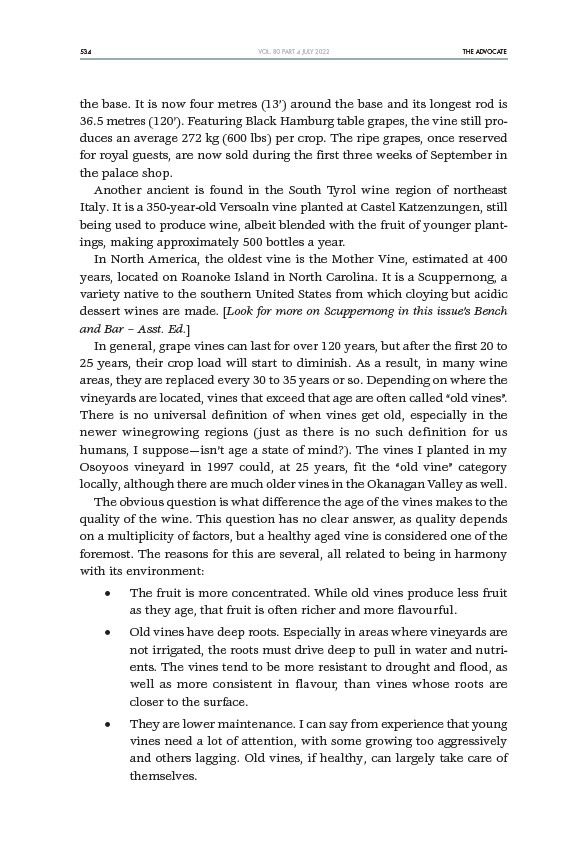
534 THE ADVOCATE
VOL. 80 PART 4 JULY 2022
the base. It is now four metres (13’) around the base and its longest rod is
36.5 metres (120’). Featuring Black Hamburg table grapes, the vine still produces
an average 272 kg (600 lbs) per crop. The ripe grapes, once reserved
for royal guests, are now sold during the first three weeks of September in
the palace shop.
Another ancient is found in the South Tyrol wine region of northeast
Italy. It is a 350-year-old Versoaln vine planted at Castel Katzenzungen, still
being used to produce wine, albeit blended with the fruit of younger plantings,
making approximately 500 bottles a year.
In North America, the oldest vine is the Mother Vine, estimated at 400
years, located on Roanoke Island in North Carolina. It is a Scuppernong, a
variety native to the southern United States from which cloying but acidic
dessert wines are made. Look for more on Scuppernong in this issue’s Bench
and Bar – Asst. Ed.
In general, grape vines can last for over 120 years, but after the first 20 to
25 years, their crop load will start to diminish. As a result, in many wine
areas, they are replaced every 30 to 35 years or so. Depending on where the
vineyards are located, vines that exceed that age are often called “old vines”.
There is no universal definition of when vines get old, especially in the
newer winegrowing regions (just as there is no such definition for us
humans, I suppose—isn’t age a state of mind?). The vines I planted in my
Osoyoos vineyard in 1997 could, at 25 years, fit the “old vine” category
locally, although there are much older vines in the Okanagan Valley as well.
The obvious question is what difference the age of the vines makes to the
quality of the wine. This question has no clear answer, as quality depends
on a multiplicity of factors, but a healthy aged vine is considered one of the
foremost. The reasons for this are several, all related to being in harmony
with its environment:
• The fruit is more concentrated. While old vines produce less fruit
as they age, that fruit is often richer and more flavourful.
• Old vines have deep roots. Especially in areas where vineyards are
not irrigated, the roots must drive deep to pull in water and nutrients.
The vines tend to be more resistant to drought and flood, as
well as more consistent in flavour, than vines whose roots are
closer to the surface.
• They are lower maintenance. I can say from experience that young
vines need a lot of attention, with some growing too aggressively
and others lagging. Old vines, if healthy, can largely take care of
themselves.